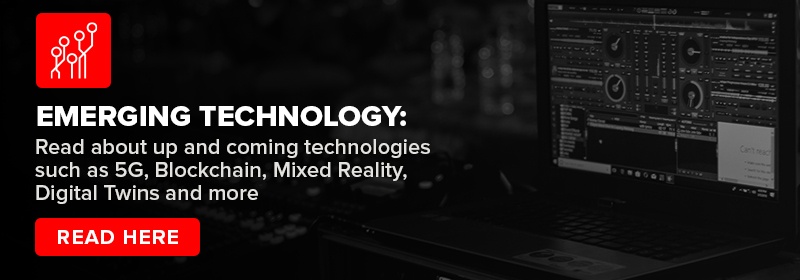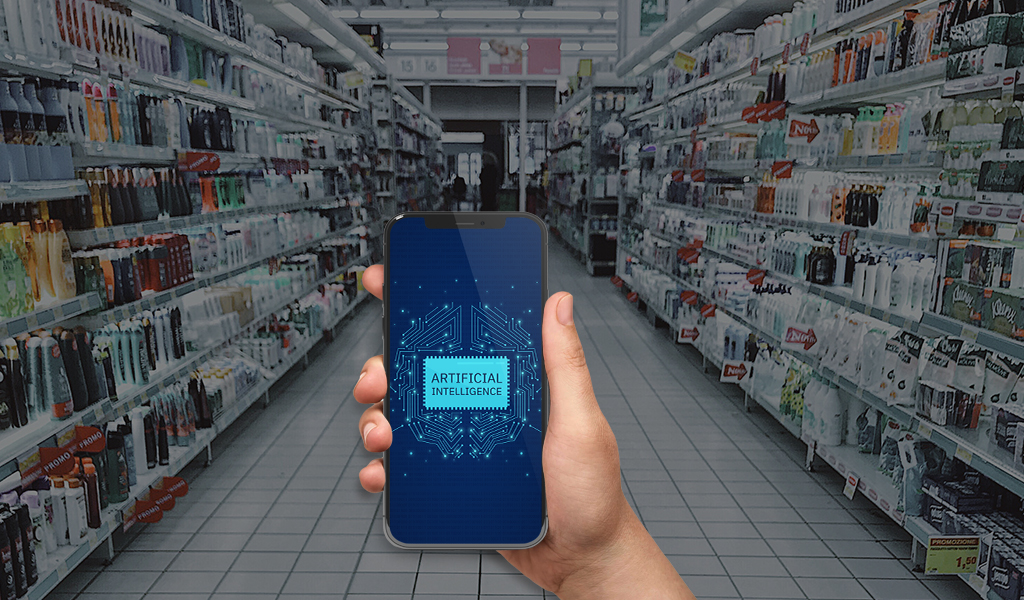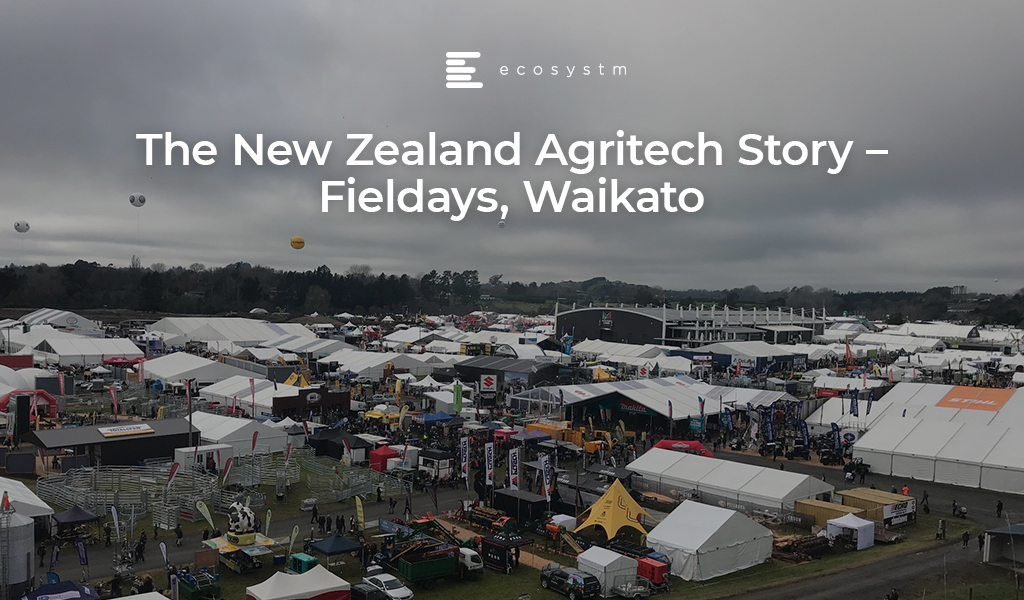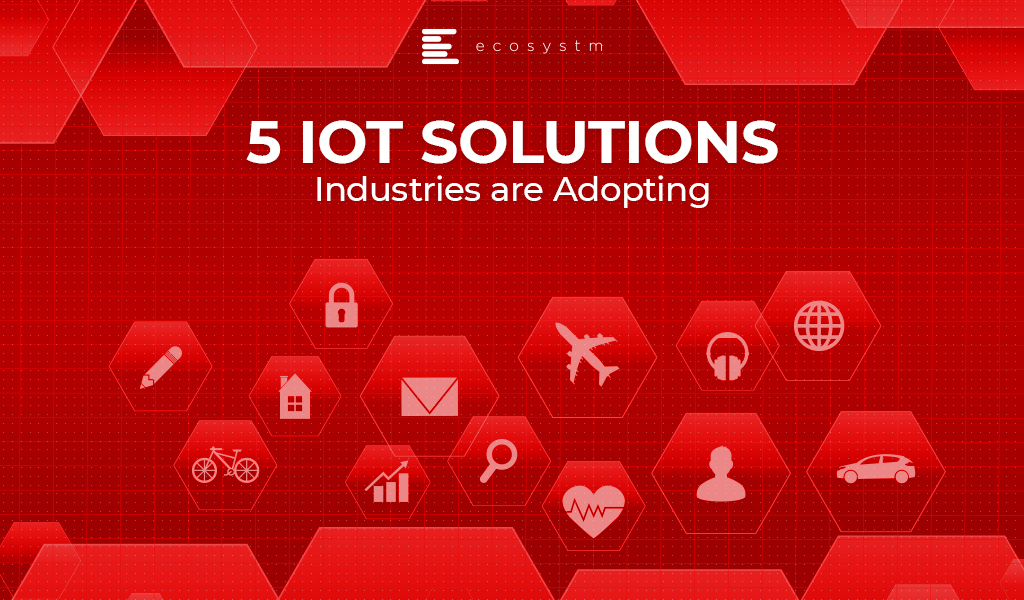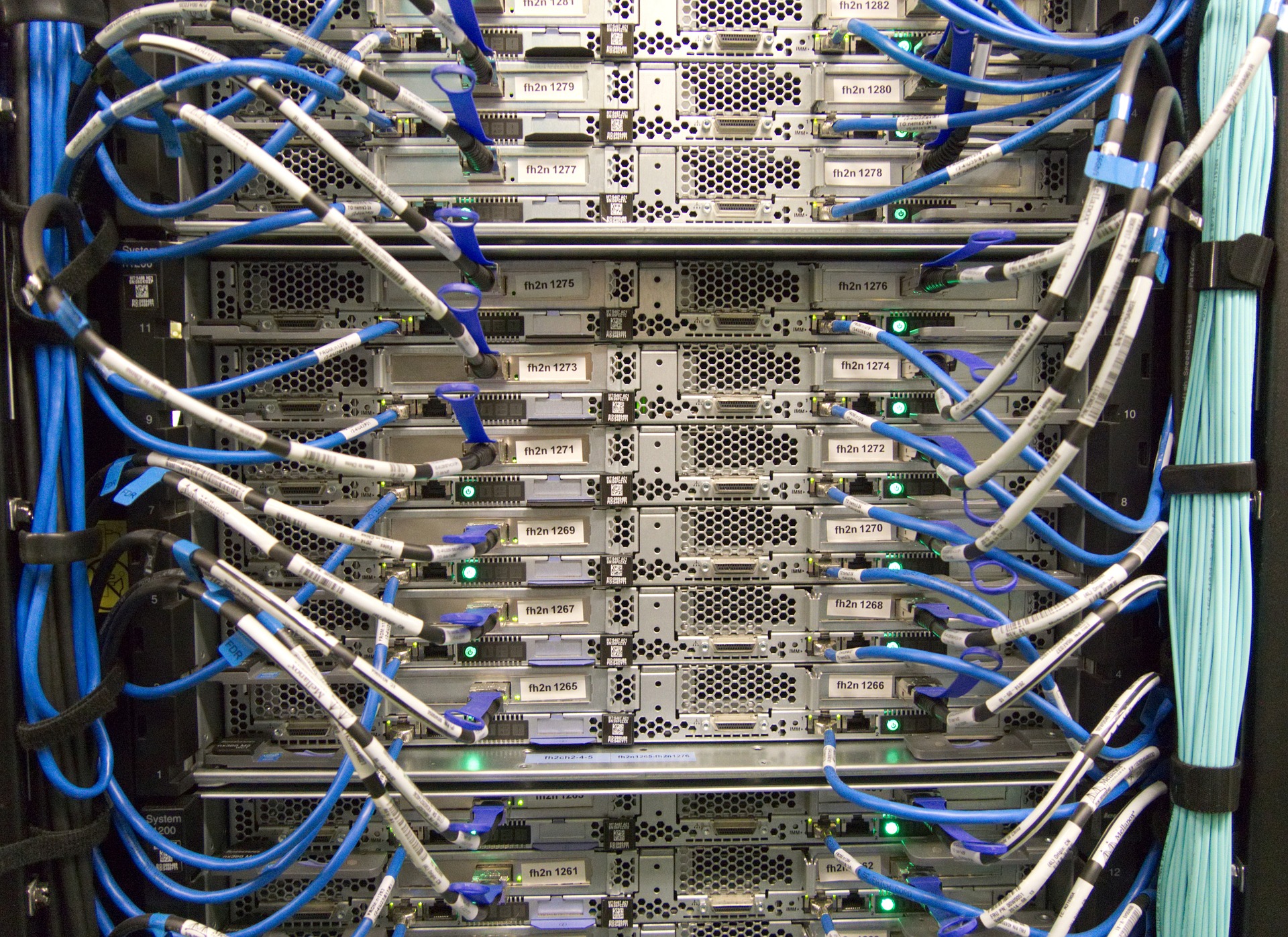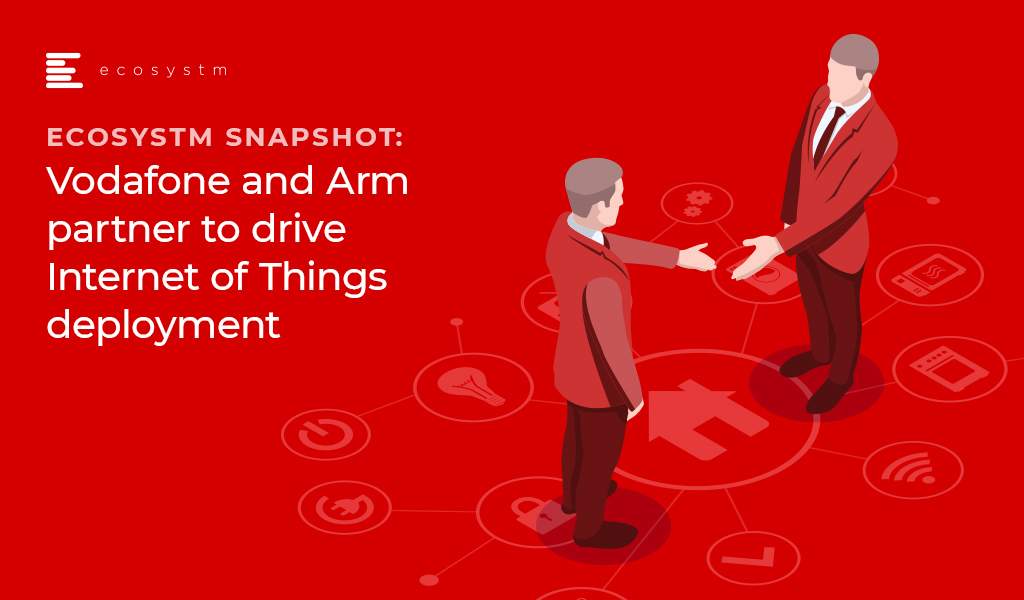Some of you may be familiar with the famous Goya painting, ‘Saturn Devouring His Son ‘, which belongs to his series of ‘Black Paintings’. It is the best comparison I can make after returning from the TechXLR8, IoT World Europe Summit in London.
In the painting we see the god Cronos/Saturn, who immutably governs the course of time, devouring one of his sons. I see Cronos as Artificial Intelligence (AI) and his son as the Internet of Things (IoT). The analogy can be carried further – there are other brothers waiting their turn to be devoured by this hungry father. Soon it will be Augmented Reality /Virtual Reality (AR/VR), Blockchain and Digital Twins.
If we look at the Ecosystm global IoT Study, we find that adopters of IoT are developing their capabilities in related technologies, with AI, Machine Learning and Predictive Analytics being the most significant. Very soon the IoT that is part of our lives will have AI embedded in them.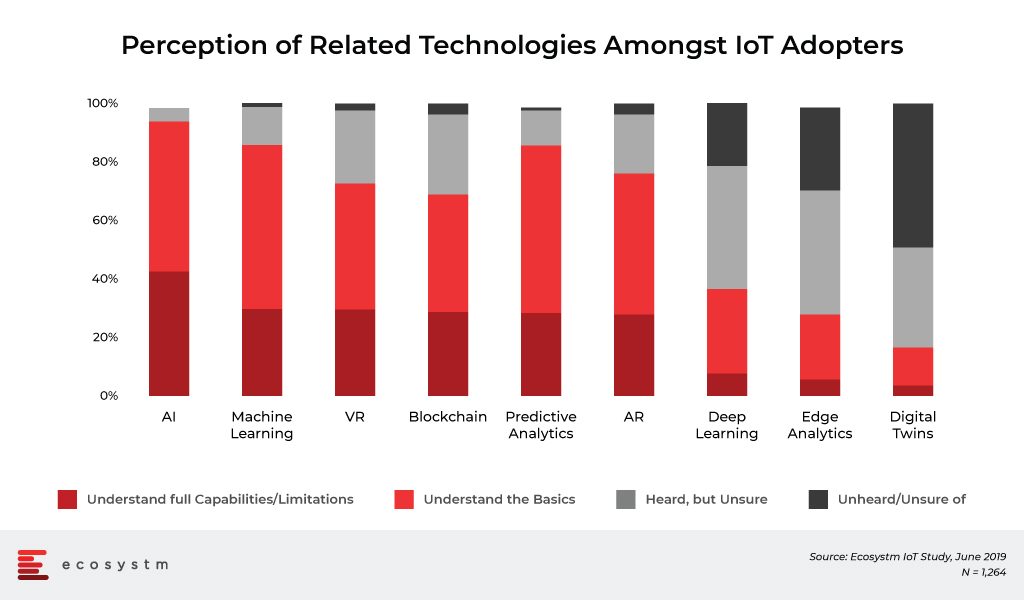
So, if you are still waiting for the IoT boom, this event is a confirmation that IoT is not throwing up many new things at least in Europe. The few IoT companies that exhibited their products and services at Excel London showed nothing that could overshadow the big winner, the ubiquitous father AI.
I have been finding it more difficult to justify coming to these IoT events. However, my role as a speaker and moderator allows me to maintain my influence and keep my followers on social networks, informed. The organisation this year has sought speakers that mix vendor presentations with success stories of clients. But this year neither of them was able to raise the tone of the event. The few large IT firms present such as Microsoft, SAP and Oracle are on the AI bandwagon and their demos on pure-play IoT are oft-repeated.
The larger systems integrators did not have adequate presence either. Many of them should have implemented IoT solutions for years but never really risked investing in IoT, and continue to focus on digitalisation projects, cloud migration projects, products updates and customised developments.
The discussions of the first years of the IoT boom revolved around connectivity, security, IoT platforms, and even business models. Now, nobody is interested in these matters anymore.
There was no significant IoT news during the event. Perhaps the most important announcement was made by Marc Overton who took advantage of his presentation to announce the recent collaboration agreement between Sierra Wireless and Microsoft to claim industry’s first full-stack IoT offerings.
As for my sessions, they mixed IoT and Blockchain, something that would have guaranteed success for attendees two years ago or even last year but that did not arouse great enthusiasm this year. It is evident that both technologies are becoming a commodity. Something that is not bad, since we would stop speculating about possible use cases and actually implement the technology in our lives and businesses.
Do not worry, the life of IoT events continues, and so this week there are three more just in Europe:
- Living bits and Things in Bled (Slovenia), during 17-18th June 2019
- IoT Tech Expo Europe in Amsterdam (Netherlands) during 19-20th June 2019
- IoT Week in Aarhus (Denmark) during 17-21st June 2019
Here is what I think event organisers and Tech vendors should keep in mind:
- Organisers need to find a way to facilitate meetings between vendors and attendants – and focus on how to create indirect lead generation opportunities. This would be mutually beneficial for all concerned.
- Organisers and exhibitors need to try to reinvent these IoT events where we see IoT present in every corner of the floor, in every stage, in every service (cafeteria, rest rooms, transportation….). We need to breath IoT every minute.
- IoT vendors need to demonstrate that they are working with partners and not present isolated use cases or demos. We need to see that “intelligent things” from different vendors in the exhibition area are interconnected.
Otherwise the IoT events will continue to drive away both visitors and exhibitors. What would you like to get out of future IoT events? Let me know.
The largest agricultural event in the southern hemisphere has just come to a close in Waikato New Zealand, across 114 hectares, with over 1,050 exhibitors, more than 125,000 visitors, including delegates from over 40 countries, and total sales revenue of around half a billion over the four days. Fieldays, an idea from the late 1960s focused on connecting farmers with innovative products and services, was officially opened by the Rt. Hon. Jacinda Ardern who spoke of the strength of New Zealand’s primary industry and its importance to the people of New Zealand. Of specific interest to me as I joined the crowds on day two, was the emerging technology innovations in agriculture on show at the Innovation Centre.
A preview of the New Zealand Agritech Story, developed along with New Zealand Trade and Enterprise (NZTE), was kicked off on a foggy Waikato morning on day two of Fieldays, providing insights into the country’s competitive advantage in Agritech along with perceptions of key global players. This was then followed by the New Zealand government announcing a new $20 million Agritech investment venture fund.
NZ Tech reports that the tech sector in New Zealand is the third largest and fastest growing export sector, worth $6.3 billion in 2015, and according to the TIN100, the Waikato, has had the fastest growing tech sector in the country two years in a row. New Zealand Agritech exports stand at $1.4 billion in 2018 and is growing – and together with a strong tech sector overall, the investment will help position New Zealand at the forefront of Agritech innovation globally.
Day two also revealed Fieldays Innovation Award winners across a range of categories including Modusense who took out the Gait International Innovation Award for Product Design and Scalability. Modusense, developed here in the Waikato, is a secure, scalable and reliable Internet of Things (IoT) device platform that provides everything needed to deploy remote data collection. In the primary industries sector, Modusense enables complete apiary health monitoring.
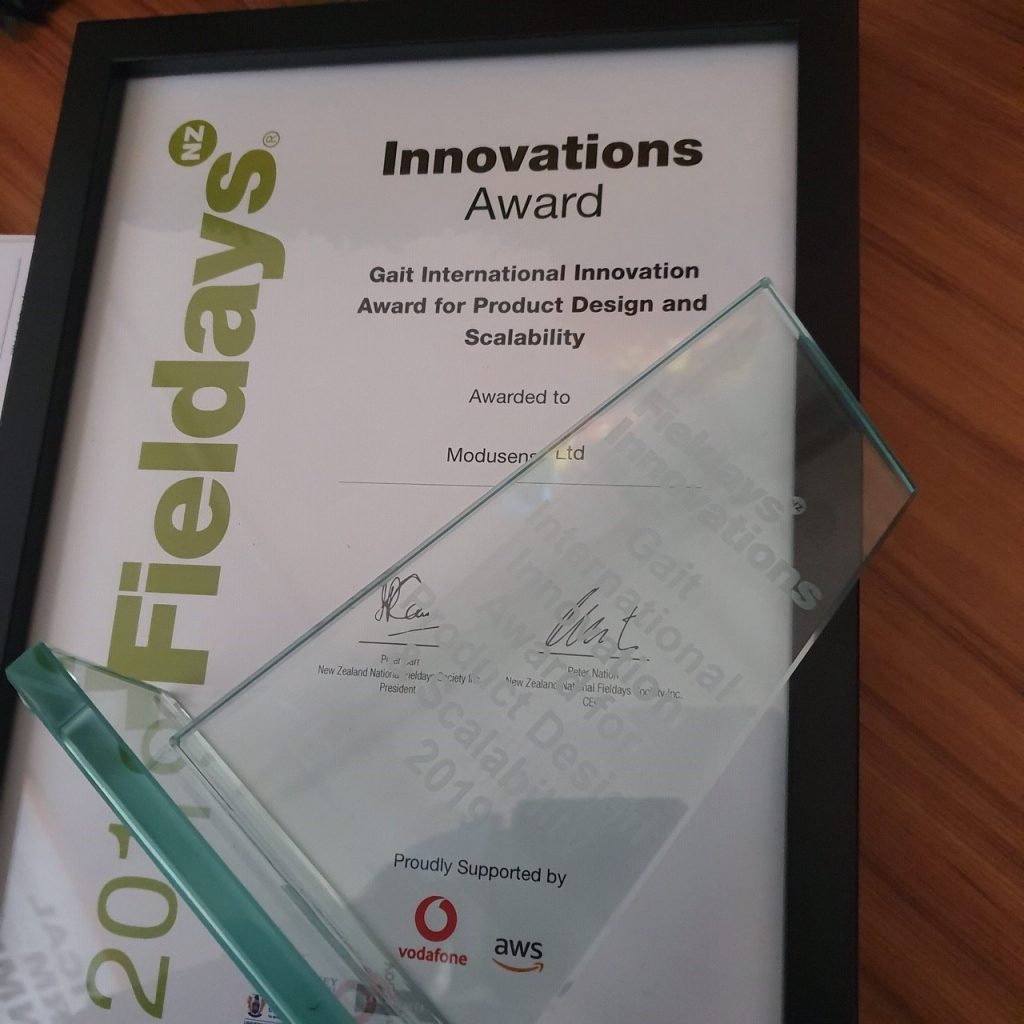
Another IoT enabled solution, RiverWatch, was awarded the AWS Innovation Award in Data for their “Fitbit for water” – an inexpensive water quality monitoring device. RiverWatch is currently running trials in the upper Waikato River in partnership with Te Arawa River Iwi Trust to look at the impacts of industry and farming on water health.

Agritech will transform the industry, and innovations such as those mentioned will further advance New Zealand’s position in the agriculture industry. The true value of Agritech will be realised when AI-enabled IoT is leveraged for cost savings through process automation, and for greater visibility of the entire supply chain. And leading organisations in the industry are aware of it. In the global Ecosystm AI study, Resource & Primary industries (including Agriculture) emerged as a leader when it comes to current and future deployments of IoT Sensor Analytics.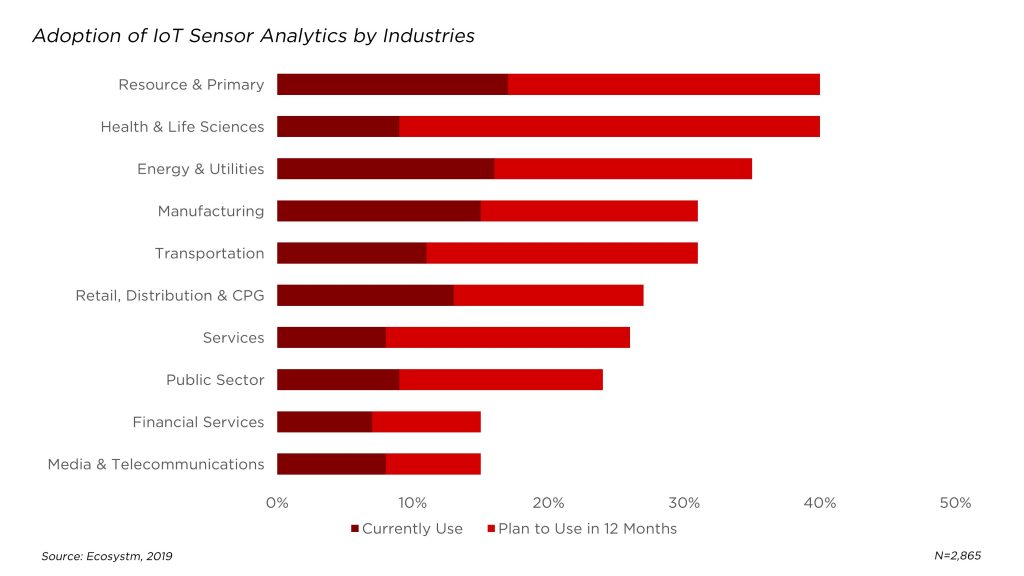
Innovations in IoT
Shipping and logistics in the agricultural sector present unique challenges including a lack of transparency, something that Sparrows.io is working to solve with a hardware and software solution that provides actionable insights using custom sensor modules and live tracking to enable visibility over the supply chain.
The recently launched TRex – IoT, Telemetry, Data and Messaging I/O Transceiver, was also being showcased in the Innovation Centre. Designed to be used for long range monitoring and control, the solution enables two-way messaging and is customisable to meet the needs of applications across various industry sectors including agriculture and farming.
Another innovation that caught my attention at the Innovation Centre was a water monitoring and management device designed to be connected to the irrigation system to enable effective management of water through a mesh network. Hailing from the deep south Next Farm has developed two solutions, with their Remote Irrigation Mesh (RIM) product utilising integrated farm sensor technology together with cloud-based dashboards allowing farmers to maximise the efficiency of water usage while minimising runoff.
Innovations in AI
One of my favourites from last year, Halter, were in the Mystery Creek Pavillion this year and after raising $8 million in funding to refine and further trial their solar-powered collar, for herding cows and monitoring their health, in the Waikato they are close to hitting the open market. Head of Data Science at Halter, Harry She, previously employed by NASA, oversees the development of what the team calls “cowgorithms” which form the basis of the AI underpinning much of the product functions. The collars, which can receive signals up to 8 kms away, is available free and farmers then subscribe on a monthly basis, at a cost per cow, to enable the features they require.
Another product back for another year was the PAWS® Pest Identification Sensor Pad from Lincoln Agritech which is able to identify pests, differentiating these from native species, and transmit the result to the Department of Conservation staff. Utilising machine learning and AI, amongst other technologies, the device greatly reduces surveillance workload and enables staff to detect and respond to re-invasion more rapidly.

However, as exciting as the idea of a Fitbit for cows and innovation in the pursuit of a predator-free New Zealand is, I must admit the highlight of my Fieldays visit was a team of Agribusiness students from Hamilton’s St Paul’s Collegiate school who were awarded the Fieldays Innovations Young Innovator of the Year Award for their floating electro unit “Bobble Trough” designed to keep animal water troughs clean by preventing the growth of algae and microorganisms through the release of copper ions into the water.
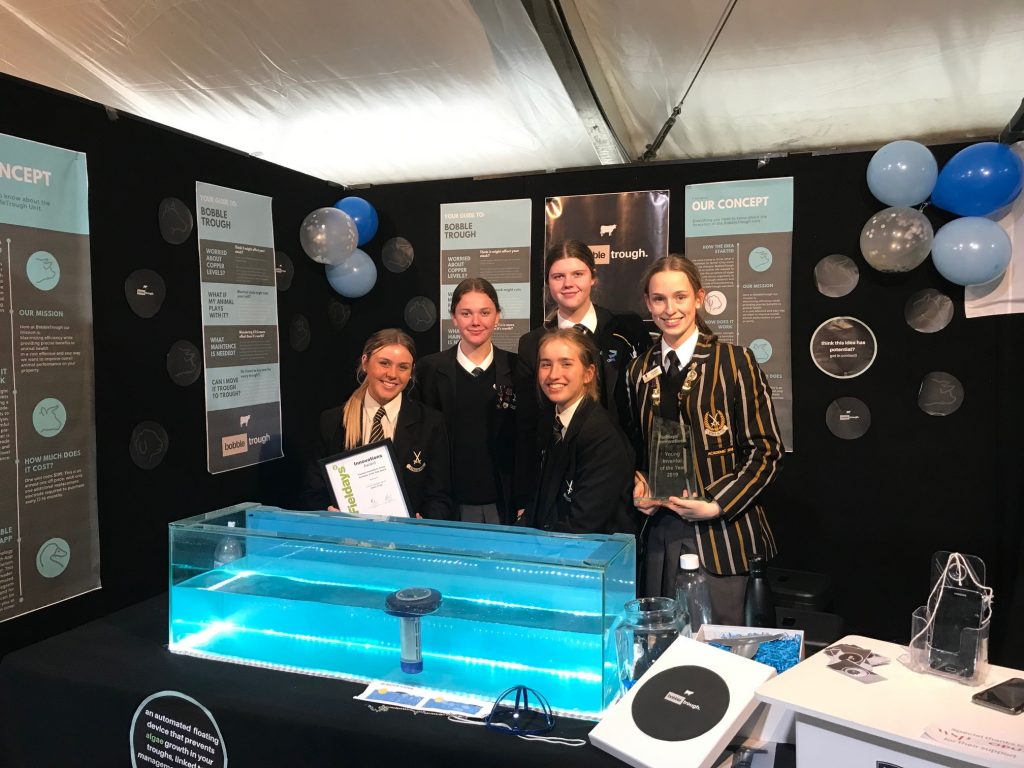
I am now working to secure the team’s innovation as a display in a Smart Space being launched in July as part of the Hamilton City Council’s smart cities initiative, Smart Hamilton. A space designed to provide an opportunity for the wider community to engage with technology innovation and be involved in co-creating solutions that enhance the wellbeing of Hamiltonians.
For information on emerging technology innovation in the agriculture sector in New Zealand access my other reports on technology in agriculture in New Zealand.
Internet of Things (IoT) is changing how companies do business, across industries. Using connected sensors, better data processing capabilities and automation, industries are looking to achieve workforce optimisation, improved customer experience, and cost savings in the short term. In the long-term organisations are looking for service and product innovation, as well as a competitive edge from their IoT investments.
In the global Ecosystm IoT study, participants revealed the IoT solutions that are part of their larger IoT deployment projects. Here are the top 5 solutions that industries are implementing, and how they are benefitting from them.
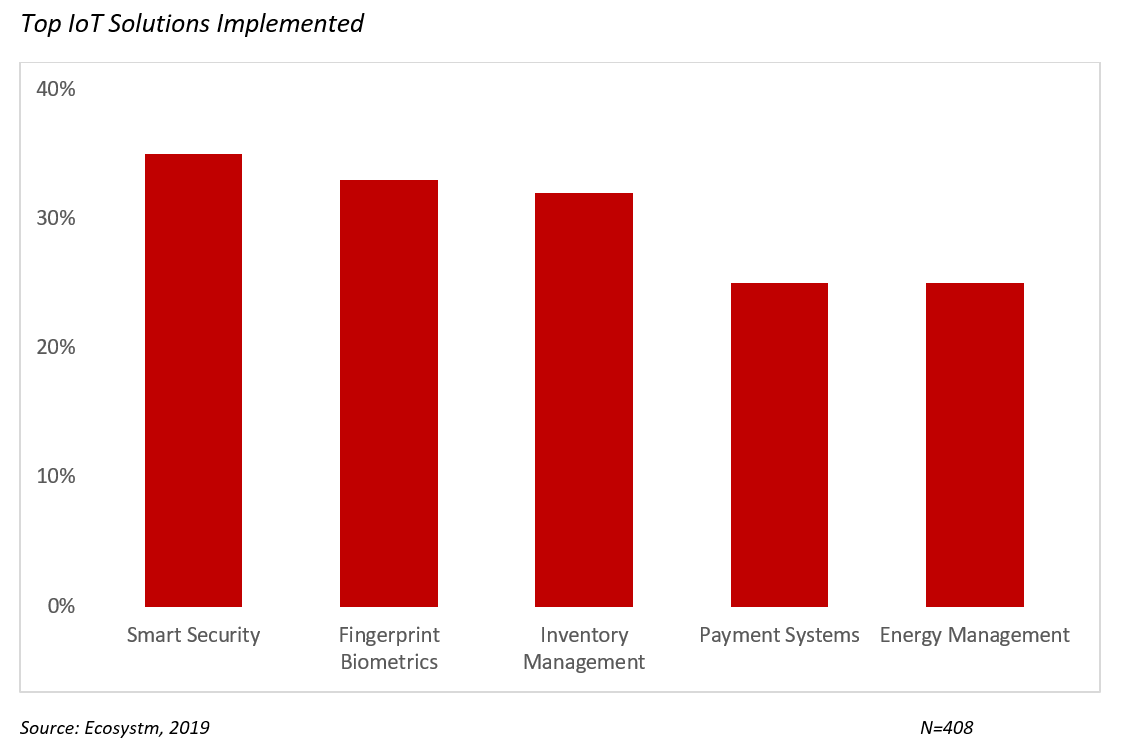
Smart Security
Smart Security is being adopted in several enterprises, especially in the Financial and Hospitality industries. Aside from improved safety, Smart Security solutions have the potential to deliver more personalised service and better customer experience (CX).
Maintaining security for the guests is one of the top concerns for hotels and smart video surveillance systems, motion detection, audio detection, and alert systems are helping hotels to identify possible threats and get early alerts on potential events.
Hotel chains Hilton and Marriott are leveraging Smart Security IoT solutions to create better travel and stay experiences for guests. They are working on creating enhanced security for their visitors by replacing card-based door keys. Simultaneously, smartphone applications connected with hotel sensors and devices are offering a seamless experience to guests with automated room settings such as HVAC, lighting, and blinds.
The Banking industry is incorporating Smart Security as well. Banking and financial institutions attract criminals for obvious reasons and to improve security, smart CCTV surveillance, wedge barriers, laser scanner detectors, light barriers, and quick folding gates are embedded with sensors and connected to safeguard against potential attacks. IoT-enabled network security measures to provide intelligent Perimeter Security is also seeing an uptake in the industry.
However, the proliferation of ubiquitous devices also leaves organisations vulnerable to data breaches. Digital and electronic devices incorporated into a hotel’s infrastructure can be exploited by hackers or may jeopardise the security of guests. The now-famous incident of the casino in the US that was hacked into through the IoT-enabled temperature control system in the fish tank is a case in point.
Fingerprint Biometrics
While Fingerprint Biometrics is often a part of a Smart Security solution, it is being used more often for asset management, as well as access control. This is fairly common in industries where multiple people fill a particular role, such as Manufacturing, Retail, and Healthcare. In hospitals, for example, multiple clinicians work on the same patient order entry system. Using fingerprint biometrics ensures that there is full accountability for care delivery at any given point, irrespective of the clinician.
Biometrics and its application are redefining the banking experience for rural and the unbanked population – in emerging countries especially – as one of the key authentication methods. Biometrics is helping in e-KYC, often used to open a bank account, on-site cash delivery by scanning fingerprints, opening a bank’s wallet with fingerprint authentication, fingerprint-based ATM kiosks and fingerprint mobile ID all connected through the IoT Solutions.
Governments use fingerprint biometrics to accurately authenticate the identity of travelers, implement biometric voting systems for fair and credible elections, develop fingerprint-based national identification cards and create a composite individual identity. But with this advantage, there could be associated challenges of managing personal databases in a safe and secure environment.
Inventory Management
Better supply chain visibility and management is considered one of the most common benefits of IoT deployments, and has use cases in several industries, including Transport & Logistics, and Primary industries. Inventory management became a lot easier and reliable, when IoT sensors and devices can do remote stock taking and track inventory movement.
IoT will enable more holistic inventory management, as asset tracking, asset management and eventually predictive maintenance, are incorporated within the IoT system. Supply chain requirements of Manufacturing organisations can vary vastly – a discrete manufacturing supply chain will vary from a FMCG supply chain. IoT sensors have made ‘track and trace’ more reliable, and easy to customise. eCommerce giant Amazon’s inventory management and warehousing system is a good example. To manage the large stock, the storage facilities employ pickers (robots) to pick items from and replenish stock on shelves which in turn improves receiving, pick-up, and shipping times. The inventory is scanned through barcodes which also helps in aggregating information from other warehouses for stock maintenance.
Several Retail organisations make full use of IoT for inventory management. G-Star Raw, for example, uses garment RFID tags to track inventory movements across the supply chain and store shelves. Being able to locate clothes on the basis of style, colour and size in the stores makes the order fulfillment reliable and more real-time.
Payment Systems
Several industries other than Financial Services, such as Hospitality, Services, Healthcare and Government are evaluating IoT-enabled payment systems such as mobile points of sale and NFC payments.
On most occasions, these are being promoted by financial institutions. As an example, MasterCard has created a Mastercard Engage platform with technology partners resulting in innovations which include contactless payments (with Coin), smart refrigerators that can re-order groceries (with Samsung) and IoT-connected key fobs (with General Motors). Capital One has made it possible for its customers to pay bills via Alexa, whereas Starling is experimenting with integration with Google Home to enable queries on payments and balances on the Google Home platform.
There are also several use cases that are not so obvious –Amazon Go offers a shopping experience where no check-out is required. Your Amazon account, wallet and phone are all inter-connected. When a consumer arrives at a store the application allows store entry, tracks the consumer through the shopping journey and requires no formal check-out at the end of the shopping trip.
However, IoT-enabled payment systems will have to evolve as industries become increasingly services based. There needs to be a focus on the business and not just technology – defining workflows with the right alerts that will automate bill generation and the payment process, irrespective of how complicated the service delivered is.
Energy Management
Resource shortage and the ever-increasing price of energy has forced organisations to identify innovative ways of conserving energy. A Smart energy management system can help to reduce the costs and energy consumption while still meeting energy needs. IoT is helping companies to achieve their energy goals, predict maintenance needs, and increase the reliability of energy assets. Smart energy solutions continuously analyse energy data to ensure dynamic performance which in turn manages energy requirements.
Take an example of a smart building management system where date from various sensors is collected and analysed, such as from HVAC, air-quality monitors, and other equipments, and lighting, heating, air ventilation, elevators, room equipment are remotely operated according to the building energy requirements at the moment. This technology helps make smart decisions and provides energy efficiency.
Capital Tower in Singapore, a 52-storey high building, is not alone in being energy efficient. It has a number of in-built smart energy solutions for energy and water efficiency. The building has motion detectors in elevators, smart car parking system, exterior structure glasses which help reduce energy consumption, and water conservation through condensation of air conditioning units. The building has devices to monitor oxygen and carbon dioxide levels ensuring optimal air quality which results in significant energy savings while delivering comfort for tenants.
As is clear from the solutions that are being currently deployed, IoT adoption is at its nascency. As IoT deployments mature, there will be more industry-specific uses of IoT, and a shift of focus from asset management to people management (including customers).
What IoT solutions do you use/ intend to use in your organisation? Let us know in your comments section below.
This is an abstract of my presentation in Dubai on 23rd April 2019. I want to convey my special thanks to Dr. Eesa Bastaki, President of the University of Dubai for inviting me on the occasion. It was a magnificent experience delivering at such a great University.
In the year 2016, I considered Rio as the first Internet of Things (IoT) Olympic games in my article “The future of “The Internet of Olympic Games”. In Rio, we saw how athletes, coaches, judges, fans, stadiums, and cities benefited from IoT technology and solutions which transformed the way we see and experience sports. Next year we will have another opportunity to validate my predictions for the upcoming Tokyo 2020 Summer Olympics. Therefore, we may designate Tokyo as the first Artificial Intelligent (AI) Olympic Games.
During my presentation at the University of Dubai, I explained to the audience how incredible IoT and AI technologies are and to what extent they are impacting our sports experience. I elaborated on IoT and AI’s significant role in health management, improving aptitude, coaching, and training. These technologies are enabling athletes to improve performance, coaching for better preparation, fewer judgment errors, and a better experience for spectators. I also commented on the importance of IoT and AI to enhance the security of teams, audience, stadium, and cities altogether.
With the use of IoT and AI we are creating a world of smart things transforming sports business where every thousandth part of a second is crucial to predict the outcomes of a race, a match or a bet. I cited various examples on how different sports are utilising IoT and AI, and not in the least I shared a vision of the future that’s like 10-15 years onwards from the present – Can you envision a world of a real and virtual world of sports integrated together? Can you visualise robots and humans or super-humans playing together?
On the other side, speaking of the challenges involved with AI, IoT, and machine learning models for sporting, I conveyed the dark side of these technologies. We cannot forget the fact that the sports industry is a market and therefore enterprises, Governments, and individuals may make erroneous uses of these technologies.
In summary, it in this session I shared my point of view on-
- How IoT and AI will transform coaches, athletes, judges, and fans.
- How IoT and AI will attract the audience to the stadiums
- How IoT and AI will transform the Industry?
- How AI is changing the future of sports betting?
How IoT and AI will transform athletes, coaches, judges and fans?
Athletes
While the true essence of a sport still lies in the talent and perseverance of athletes, it is often no longer enough. Therefore, athletes will continue to demand increasingly sophisticated technologies and cutting-edge training techniques to improve performance. For example, we may see biomechanical machine learning models of players to predict and prevent potential career-threatening physical and mental injuries or can even detect early signs of fatigue or stress-induced injuries. It can also be used to estimate players’ market values to make the right offers while acquiring new talent.
Coaches
Coaches are consuming AI to identify patterns in opponents’ tactics, strengths and weaknesses while preparing for games. This helps coaches to devise detailed game plans based on their assessment of the opposition and maximise the likelihood of victory. In many leading teams, AI systems are used to constantly analyse the stream of data collected by wearables to identify the signs that are indicative of players developing musculoskeletal or cardiovascular problems. This will enable teams to maintain their most valuable assets in prime condition through long competitive seasons.
Judges
We tend to think that technology is helping us to make decisions in sports more accurate and justified. That´s why we look at the inventions such as from Paul Hawkins – creator of Hawk-Eye, a technology that is now an integral part of the spectator’s experience when watching sport live or more recently VAR in soccer.
The use of technology is allowing the decision makers to experience the game with multiple cameras angles in real-time combined with the aggregated data from various sensors (stadiums, things, and athletes) thus making them make more objective and accurate decisions.
We as spectators or fans need more transparency about the exercise’s difficulty, degree of compliance and final score. And we have the technology to do it.
The IoT and AI technology don’t claim to be infallible – just very, very reliable and judges also need to be adapted to new technologies.
Fans
Without fans, sports would find it difficult to exist. It is understandable companies are also targeting fans with IoT and AI to keep them engaged whether in the stadium or at home.
How IoT and AI will attract the audience to the stadiums?
The stadiums, sports clubs and many leagues across the globe are incorporating technologies both inside and outside the stadium areas to boost the unique experiences for fans and not only during the gameplay.
The challenge is how to combine the latest technologies with old-school stuff to please supporters from both newer and older gen. people looking forward to witnessing a game in a stadium?
How will the stadiums of the future be? I read numerous initiatives of big clubs and leagues, but I am excited about the future stadium of Real Madrid. I wish the club would allow me to advise them how to create a smart intelligent Global environment to provide each fan with an individual experience, know who is in the crowd, learn fan behaviors to anticipate their needs.
How IoT and AI will transform the Industry?
“As long as sports remain a fascination for the masses, businesses will always have the opportunity to profit from it. As long as there is profiting to be gained from the world of sports, the investment in and incorporation of technology for sports will continue.”
I went through an article warning about an entirely new world order that is being formed right now. The author explained how 9 companies are responsible for the future of AI. Three of the companies are Chinese (Baidu, Alibaba, and Tencent, often collectively referred to as BAT), while the other six are American (Google, Amazon, IBM, Facebook, Apple, and Microsoft, often referred as the G.Mafia). The reason is obvious, as far as AI is about optimisation using the data that’s available, these 9 companies will manage most of the sports data generated in the world.
Collaboration is needed now to stop this threat and to address the democratisation of AI in sports. It is important that companies and Governments around the globe work together to create guiding principles for the development and use of AI and not only in Sports. This means we need regulations but in a different way. We do not want AI power to lie only in a handful of lawmakers, renowned and smart people who lack skills in IoT and AI.
Will AI change the future of sports betting?
The impact of technology on sports cannot be specifically measured, but some technological innovations do raise questions about fairness. Are we still comparing apples with apples? Is it right to compare the speed of an athlete wearing high-tech running shoes to one without?
Whether we like it or not, technology will continue to enhance the athlete’s performance. And at some point, we will have to put specific rules and regulations in place about which tech enhancements are allowed.
There is a downside to advanced technology being introduced to sports. Nowadays, Machine Learning models are routinely used to predict the results of games. Sports betting is a competitive world itself among fans, but AI can substantially tilt that playing field.
I am afraid that IoT and AI companies may spoil the result predictions but more concerned about the manipulation of competitiveness that AI algorithms could bring with the Terabytes of data collected with IoT devices and other sources like social media networks, without the permission of the users.
The sports industry is already generating billions of dollars every year and without control and awareness, we could find the future generation of ludopaths and a small number of service providers controlling the game.
Let me know what else would you like to see in my future posts. Leave your comments below.
In the last few weeks, there have been announcements in Canada and Denmark on nationwide IoT networks launches. Moving away from pilot projects, test cases, implementations across large factories and campuses or even citywide networks to drive smart city initiatives; these countrywide IoT networks give organisations access to lower cost means to implement large, more integrated, IoT projects.
Sigfox Canada announced the launch of Canada’s first coast to coast low-bandwidth IoT network which is the nation’s first IoT network on such a scale. The network leverages low-power wide area network (LPWAN) technology offering a capacity to support millions of IoT sensors. The solution is anticipated to provide efficient and cost-effective connectivity for businesses looking to adopt IoT technology.
Similarly, Teracom, a Denmark-based telecom operator in partnership with Loriot, (an IoT infrastructure provider) announced an IoT LoRaWAN – Long Range Wide Area Network network in Denmark. We have previously seen the Netherlands implementing a nationwide long range (LoRa) network for IoT and Singtel’s commercially available narrowband Internet of Things (NB-IoT) network in Singapore.
“There is no doubt that services like LoRaWAN will help boost early adoption of IoT services and at this stage, there is a segment of the market which is a good fit. However, the longevity of LoRaWan is less certain. Compared to LoRaWAN, NB-IOT has arguably been too late to the game and it may fail in the short term but may very well win in the long term.” says Copenhagen based Ecosystm Principal Analyst, Claus Mortensen.
Efforts are being made by both the Sigfox and Teracom to enhance the network coverage and quality in the countries. A lot of the focus on IoT in Denmark has been bundled into the future deployment of 5G. However, most IoT applications do not need high bandwidth.
“The issues with large countries such as Canada, Australia, and the US is how do you economically cover large geographic area with a very varied population density? In contrast, smaller countries like Denmark can have a mesh thrown over them very easily” says Ecosystm Executive Analyst, Vernon Turner.
With 5G though, the telecom providers appear to be in a better position as they understand that 5G will be driven by the enterprise segment in the short to medium term and they have been actively involved in developing use cases from the get-go which also includes a focus on IoT services.
IoT offers a plethora of opportunities to companies looking to adopt or expand the country-wide networks. Both mature countries and emerging economies are at dissimilar life-cycles in their degree of IoT technology adoption but we expect to witness more technology sharing and network concatenation in the near-future.
Is the IoT fueling a Digital Ecosystem to enable widespread Digital Transformation?
Ready or not, digital transformation (DX) is here and is already revealing its impact on every aspect of our lives. In some cases, the transformation is obvious. Take the way we call for a ride-share or taxi, find a room to stay, or chat to a robot for your favourite song – these are all part of mainstream DX. More subtle examples, with a Digital Ecosystem working behind the scenes, can be found in things like checking out at the retail store without ever opening your wallet or jumping into the latest automobile and getting your directions mapped out for you.
DX is often described as the integration of digital technology into all areas of business while changing how you operate and deliver value to customers. Advancements involving cloud computing, analytics, social and mobile technologies are reshaping the customer experience (CX) and opening the door for innovation and new business services. DX is also a cultural change that requires organisations to continually experiment with new ideas while being comfortable with failure and accepting that speed has become a business imperative for everyone.
DX will fundamentally change the way we think about creating a product and how we take it to market. Gone are the days of ‘make and sell’— that is, finding a market (after the fact) for the latest bright and shiny invention or innovation and forgetting about the “thing” that’s left behind with the customer. We have flipped from building stagnant technology-for-technology’s sake, as well as having little or no real-time information about most of the product’s lifecycle, to now creating customer-centric solutions teeming with data about everything at all times.
What’s fueling this major shift? The widespread connection of things to the Internet that had never been connected before, including machine-to-machine connectivity. All thanks to embedded smart sensors making IoT an omnipresent phenomenon. By 2025 there will be over 80 billion ‘things’ connected to the Internet which in turn will provide input to feed digitally transformed companies. Industrial business models everywhere will also flip to a ‘sense and respond’ environment where customers and suppliers will know almost everything there is to know about the service or product being sold and delivered to us (within the realms of data privacy regulations).
The Emergence of the Digital Exchange
In the midst of this DX there is vast opportunity: a new customer engagement model to make things better and easier for everyone. Digital businesses cannot be built and serviced by a single supplier – it’s just too complex. There are too many new sources of IoT data that are used to feed business systems and to drive outcomes. Instead, we are seeing businesses that serve the same set of customers from consortia or digital ecosystems or digital exchanges made up of a wide range of participants with an equally wide range of talents and needs.
As more companies become digital, we expect that there will be thousands of ecosystems in existence across every industry. In this collaborative environment, companies with a mutual interest in a particular industry — sometimes crossing traditional industry lines — will join a digital exchange whereby they can openly innovate and scale their business by tapping in to a global community. Just think of the power and value of the exchange as being similar to the network effect (something like Metcalfe’s Law) whereby the more the participants engage in activities in the exchange, the more value everyone gets out of the digital exchange. Microsoft’s Satya Nadella calls this “creating more surplus outside us.”
Some of the key benefits we can expect from the digital exchange are:
- Co-innovation between startups looking for partners and established vendors looking for external ideas for product improvement
- Collaboration to solve like-minded industry challenges
- Creation of open and interoperable tools to speed up new products and services offerings
- Ability to leverage a large and diverse set of partners who can help each other discover new markets and services within their own industry and beyond
Digital exchanges can be wild and confusing, and they may seem disorganised to the newcomer. Think of the first impression you have when you walk into a large open-air market selling antiques. Initially everything seems to be piled into stalls with no logical reason. However, to the experienced shopper and stall owner, there is an organised manner to it that makes sense. And there are many wonderful things waiting to be revealed.
At this year’s Hannover Messe an original example of a digital exchange was rolled out by Schneider Electric called Schneider Electric Exchange — their digital ecosystem and business platform. Schneider Electric Exchange also has a structure to it that is geared up to help specific roles or personas and make it easier for anyone to find the right partner for solving specific business challenges. It is also set up to step someone through the life-cycle process of creating a solution by connecting them to the right tools with the right partners for the right markets. Business value can be created within the Exchange but is equally powerful outside when delivered to the end user. For example, building management designers can use Schneider Electric Exchange to find partners who are also experts of emerging technologies such as digital twins, 3D-Print, AR, and analytics.
We believe that digital exchanges will create immediate economic benefits by reducing friction and inefficiencies in the overall customer supply chain. Participants will be able to innovate faster and deliver quicker — even as customers’ experiences and expectations rise, evolve, and change at the lightning pace of the digital economy. Over time we expect that vendors’ Net Promoter Score (NPS) to rise as a result of improved business processes from these exchanges.
In conclusion, IoT will be the pebble that creates the ripple in the DX pond. Data will be created from every sensor that will be used to create competitive differences at every stage of a company’s value chain. Businesses that do not embrace the use of the data and innovate themselves as well as their products do run the risk of being very quickly disrupted. Companies also do not have the financial and technical resources to do all of this by themselves – hence, the opportunity to be part of a digital exchange is the way to be agile, cost-effective, and competitive. Every time, businesses that waited while a new ‘industrial revolution’ was taking place, lost out. Today, who will dare to disrupt instead of being disrupted? We are at the tipping point of digital transformation and there is no time left to sit on the sidelines – businesses need to jump in to a dynamic digital ecosystem and partner with each other through their industry’s digital exchange!
Two things happened recently that 99% of the ICT world would normally miss. After all microprocessor and chip interconnect technology is quite the geek area where we generally don’t venture into. So why would I want to bring this to your attention?
We are excited about the innovation that analytics, machine learning (ML) and all things real time processing will bring to our lives and the way we run our business. The data center, be it on an enterprise premise or truly on a cloud service provider’s infrastructure is being pressured to provide compute, memory, input/output (I/O) and storage requirements to take advantage of the hardware engineers would call ‘accelerators’. In its most simple form, an accelerator microprocessor does the specialty work for ML and analytics algorithms while the main microprocessor is trying to hold everything else together to ensure that all of the silicon parts are in sync. If we have a ML accelerator that is too fast with its answers, it will sit and wait for everyone else as its outcomes squeezed down a narrow, slow pipe or interconnect – in other words, the servers that are in the data center are not optimized for these workloads. The connection between the accelerators and the main components becomes the slowest and weakest link…. So now back to the news of the day.
A new high speed CPU-to-device interconnect standard, the Common Express Link (CXL) 1.0 was announced by Intel and a consortium of leading technology companies (Huawei and Cisco in the network infrastructure space, HPE and Dell EMC in the server hardware market, and Alibaba, Facebook, Google and Microsoft for the cloud services provider markets). CXL joins a crowded field of other standards already in the server link market including CAPI, NVLINK, GEN-Z and CCIX. CXL is being positioned to improve the performance of the links between FPGA and GPUs, the most common accelerators to be involved in ML-like workloads.
Of course there were some names that were absent from the launch – Arm, AMD, Nvidia, IBM, Amazon and Baidu. Each of them are members of the other standards bodies and probably are playing the waiting game.
Now let’s pause for a moment and look at the other announcement that happened at the same time. Nvidia and Mellanox announced that the two companies had reached a definitive agreement under which Nvidia will acquire Mellanox for $6.9 billion. Nvidia puts the acquisition reasons as “The data and compute intensity of modern workloads in AI, scientific computing and data analytics is growing exponentially and has put enormous performance demands on hyperscale and enterprise datacenters. While computing demand is surging, CPU performance advances are slowing as Moore’s law has ended. This has led to the adoption of accelerated computing with Nvidia GPUs and Mellanox’s intelligent networking solutions.”
So to me it seems that despite Intel working on CXL for four years, it looks like they might have been outbid by Nvidia for Mellanox. Mellanox has been around for 20 years and was the major supplier of Infiniband, a high speed interconnect that is common in high performance workloads and very well accepted by the HPC industry. (Note: Intel was also one of the founders of the Infiniband Trade Association, IBTA, before they opted to refocus on the PCI bus). With the growing need for fast links between the accelerators and the microprocessors, it would seem like Mellanox persistence had paid off and now has the market coming to it. One can’t help but think that as soon as Intel knew that Nvidia was getting Mellanox, it pushed forward with the CXL announcement – rumors that have had no response from any of the parties.
Advice for Tech Suppliers:
The two announcements are great for any vendor who is entering the AI, intense computing world using graphics and floating point arithmetic functions. We know that more digital-oriented solutions are asking for analytics based outcomes so there will be a growing demand for broader commoditized server platforms to support them. Tech suppliers should avoid backing or picking one of either the CXL or Infiniband at the moment until we see how the CXL standard evolves and how nVidia integrates Mellanox.
Advice for Tech Users:
These two announcements reflect innovation that is generally so far away from the end user, that it can go unnoticed. However, think about how USB (Universal Serial Bus) has changed the way we connect devices to our laptops, servers and other mobile devices. The same will true for this connection as more and more data is both read and outcomes generated by the ‘accelerators’ for the way we drive our cars, digitize our factories, run our hospitals, and search the Internet. Innovation in this space just got a shot in the arm from these two announcements.
Vodafone and Arm announced a strategic agreement at MWC19 to work on simplifying IoT services and reduce the costs confronted by the organisations on the implementation of IoT.
The Vodafone-Arm agreement expands on the previous collaboration which was on integrated SIM (iSIM) technology, a system on chip(SOC) design which can be reprogrammed with respect to the requirements. The iSIM allows customers to remotely provision and manage IoT devices across the globe which proposes reduced complexities and offers significant cost reduction.
To carry on the existing relationships this agreement is expected to bring Vodafone’s IoT global platform and Arm’s IoT software services to offer organisations a world of connected systems. This characterises a major initiative enabling a wide ecosystem of manufacturers to tap into the potential of trillions of connected devices.
Speaking on the subject, Ecosystm’s Executive Analyst, Vernon Turner thinks that “this announcement will help customers who look to and need a cellular-based IoT solution. Traditionally, mobile devices require a physical process to change their SIM (Subscriber Identity Module) card when there is a change of ownership or carrier, but in a world of trillions of connected devices, this is just not practical.”
Arm’s announcement of its iSIM is the latest in a series of announcements to resolve the size, cost, and scalability of SIM cards. SIM cards are critical for secure identity so the challenge has been to create a cost-effective IoT System On Chip (SOC) that has the SIM function embedded on it. Through its Kigen product family, Arm’s tech buyers will be able to build solutions on the latest cellular standards and specification suitable to run on 5G and backward compatible networks.
Vodafone’s customers will now be able to create a cellular-based IoT solution that can be continuously connected and deployed globally, giving them better investment protection and reduced operational costs. In addition, customers will have the choice of managing these devices through a ‘single pane of glass’ on either Vodafone’s IoT platform or Arm’s Pelion IoT Platform.
“Any time complexity is removed from an IT or mobile solution, customers respond by deploying and using that solution more” says Vernon. “ SoC-based solutions tend to have more functionality that allows for innovation, so we should expect to see an uptick in cellular-based IoT deployments”
Globally, the HealthTech innovation ecosystem has many startups working at the intersection of IoT and AI to solve some of the tough problems faced by patients and other stakeholders in the healthcare space. Several factors have led to a proliferation of a class of devices in the health, fitness and wellness space – such as, miniaturisation of sensors, advancements in microcontroller design and power management, low cost and flexible circuit design The ubiquitous availability of smartphones and always-on connectivity has enabled real-time access to cloud-based AI capabilities to transform IoT data into meaningful insights that can be used anywhere and anytime.
The key objective of healthcare provision is to engage the multiple stakeholders involved within an ecosystem to deliver better and holistic clinical outcomes.
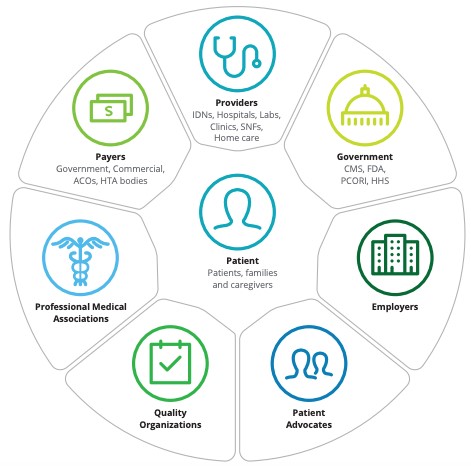
The Key Challenges to Widespread Stakeholder Acceptance
Despite the promises and great potential of IoT and AI in the healthcare industry, there are major gaps in adoption by stakeholders, especially clinicians. I believe there are three main reasons for the gap:
-
The Principle of Conservatism in Medicine
The basic premise of medicine is “Do NO Harm”. Due to the relative newness of both devices and apps, there is only a small body of knowledge and precedence for a clinician. This is too small to take a risk with using “new” data to make decisions, even though the new data may be better than other available “time-tested” options on hand.
Clinical diagnosis is based on years of medical training, time-tested knowledge and practice and clinician “Gestalt”. More often than not, the way an AI system performs the predictions is not fully understood by the clinician. Because of the relatively new field, any new AI-based prediction system will need to establish its credibility that it will NOT do any harm to the patient. Clinicians value their ability to do the right thing for the patient more than anything else.
Establishing the trust between the clinician and the black-box algorithm is critical for any successful adoption.
-
Features vs. Function
There is a lack of a common language and understanding between clinicians and technologists, especially when it comes to what “innovation” means for the other party. For a technologist, innovation lies mostly in the features and capabilities of the technology. Their mindset is that innovative technology can be easily adapted to healthcare, similar to the way mobile phones have been adopted by consumers. Their belief is that people and practices will change quickly when presented with better technology and insights. For a technologist, innovation is what transforms a practice in leaps and bounds.
For a clinician, innovation is incremental to start with, and it evolves with time. There is a widely-held belief that if a new technology is not easy to understand, then it probably will not be good. Features and capabilities do not mean much to them. Innovation MUST be simple to understand, reliable, repeatable and MUST solve a problem that they cannot solve by themselves. The arguments in the public domain whether or not AI will replace clinicians adds to the skepticism.
-
Evidence through Clinical Trials
Perhaps the biggest factor of all is that clinicians demand evidence of safety and efficacy of new technology through the lens of time-tested processes of randomised clinical trials. Unless there is evidence created by the technologists through well-designed and robust clinical trials, adoption of new technology will be a hit and miss. Technology companies interested in transforming healthcare should have a solid understanding of the clinical trials process and should create adequate scientific evidence to positively influence clinicians.
The most important aspect of gathering clinical evidence is to identify the relevant data for decision making. Many clinicians do not readily utilize the data collected from connected healthcare devices into their diagnosis and decision processes due to the lack of connections between data and clinical practice. While 10,000 steps a day might be a good benchmark for exercising right, that number means nothing if it is not connected to a clinical decision framework.
The Way Forward for Stakeholder Adoption
Healthcare leaders predict that the implementation of healthcare IoT and AI solutions on a scale will transform their industry. The next few years will see more interconnected IoT devices and reliable applications based on deep learning. To achieve adoption and impact of new technology, the innovators and healthcare stakeholder ecosystem leaders should address the need for trust and evidence. Real World Evidence and Randomised Clinical trials are effective ways to bridge the gap and to establish a common framework to address the user adoption issue.
Arun Sethuraman, Principal Advisor MedTech, Ecosystm is also the founder and CEO of Crely Healthcare, a MedTech startup based in Boston and Singapore. Infection of the surgical site, post-surgery, if not detected and treated early, leads to high incidence of mortality in patients, poor health outcomes, poor patient experience, higher healthcare costs, and loss of reputation and reduced profitability for healthcare providers. Crely’s mission is to provide an early warning and clinical decision support system for surgical site infections (SSI), post-surgery. Crely generates an early warning of SSI by algorithms based on biomarker data collected from patients using an IP-protected, secure, non-invasive, continuously wearable, clinical grade medical device.
